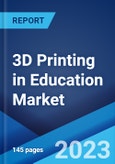3D printing in education refers to the use of 3D printers and related technologies to enhance teaching and learning experiences in educational settings. It involves the creation of physical objects or models by layering materials based on digital designs. It provides a hands-on learning experience for students and allows them to design and create physical objects, fostering creativity, problem-solving skills, and spatial reasoning. It also enables rapid prototyping and design iterations as students can quickly create and test their ideas, make improvements, and iterate on their designs. In addition, 3D printing allows students to create physical models that represent complex concepts or abstract ideas. This tangible representation helps students visualize and better understand challenging topics in subjects like biology, chemistry, physics, and engineering. Moreover, it aligns with career and technical education (CTE) programs that assists in preparing students for careers in engineering, design, manufacturing, and related fields as students can develop skills in computer-aided design (CAD), digital modeling, 3D printing technology operation, and materials science.
3D Printing in Education Market Trends:
The market is primarily driven by rapid digitization in the education sector. 3D printing offers a hands-on and experiential learning experience for students. It allows them to turn digital designs into physical objects, fostering creativity, innovation, and a deeper understanding of concepts. In addition, various advancements in 3D printing technology represent another major growth-inducing factor. Besides this, the increasing emphasis on science, technology, engineering, arts, and mathematics (STEAM) education in schools has boosted the adoption of 3D printing. 3D printing aligns well with the interdisciplinary nature of STEAM, allowing students to apply knowledge and skills from multiple disciplines to design and create 3D objects. This, coupled with the rising product adoption to prepare students for future careers is contributing to market growth. Nowadays, by incorporating 3D printing into education, students gain hands-on experience with a technology that is becoming integral to many professions. It helps develop skills in digital design, problem-solving, and prototyping, preparing students for future careers in fields that utilize 3D printing. Moreover, various key players are collaborating with educational institutions and organizations to promote 3D printing. They are also offering educational packages, which includes 3D printers, curriculum resources, and support for educators. Furthermore, the growing emphasis on personalized learning and the developing educational infrastructure are other factors creating a favorable market outlook across the globe.Key Market Segmentation:
The publisher provides an analysis of the key trends in each segment of the global 3D printing in education market, along with forecasts at the global, regional, and country levels from 2025-2033. Our report has categorized the market based on type and application.Type Insights:
- 3D Printers
- 3D Printing Services and Materials
Application Insights:
- Higher Education
- K-12
Regional Insights:
- North America
- United States
- Canada
- Europe
- Germany
- France
- United Kingdom
- Italy
- Spain
- Russia
- Others
- Asia Pacific
- China
- Japan
- India
- South Korea
- Australia
- Indonesia
- Others
- Latin America
- Brazil
- Mexico
- Others
- Middle East and Africa
The report has also provided a comprehensive analysis of all the major regional markets, which include North America (the United States and Canada); Europe (Germany, France, the United Kingdom, Italy, Spain, Russia, and others); Asia Pacific (China, Japan, India, South Korea, Australia, Indonesia, and others); Latin America (Brazil, Mexico, and others); and the Middle East and Africa. According to the report, North America was the largest market for 3D printing in education. Some of the factors driving the North America 3D printing in education market included rapid digitization in the education sector, various technological advancements, and the growing emphasis on personalized learning experiences
Competitive Landscape:
The report has also provided a comprehensive analysis of the competitive landscape in the global 3D printing in education market. Detailed profiles of all major companies have been provided. Some of the companies covered include Afinia, Fargo 3D Printing, Formlabs, Materialise NV, Prusa Research a.s, Stratasys Ltd., UltiMaker, etc. Kindly note that this only represents a partial list of companies, and the complete list has been provided in the report.Key Questions Answered in This Report:
- How has the global 3D printing in education market performed so far, and how will it perform in the coming years?
- What are the drivers, restraints, and opportunities in the global 3D printing in education market?
- What is the impact of each driver, restraint, and opportunity on the global 3D printing in education market?
- What are the key regional markets?
- Which countries represent the most attractive 3D printing in education market?
- What is the breakup of the market based on the type?
- Which is the most attractive type in the 3D printing in education market?
- What is the breakup of the market based on the application?
- Which is the most attractive application in the 3D printing in education market?
- What is the competitive structure of the global 3D printing in education market?
- Who are the key players/companies in the global 3D printing in education market?
Table of Contents
Companies Mentioned
- Afinia
- Fargo 3D Printing
- Formlabs
- Materialise NV
- Prusa Research a.s
- Stratasys Ltd.
- UltiMaker
Table Information
| Report Attribute | Details |
|---|---|
| No. of Pages | 138 |
| Published | March 2025 |
| Forecast Period | 2024 - 2033 |
| Estimated Market Value ( USD | $ 370 Million |
| Forecasted Market Value ( USD | $ 823.9 Million |
| Compound Annual Growth Rate | 9.3% |
| Regions Covered | Global |
| No. of Companies Mentioned | 7 |









